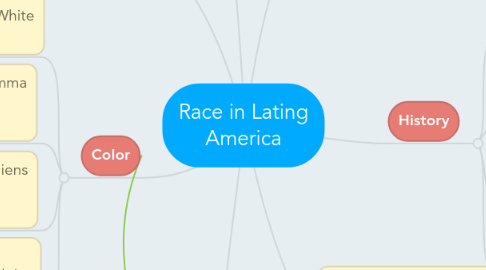
1. Education
1.1. Video 1: Less than 2% of universities though there is 80 million Blacks in Brazil.
1.2. Reading 2: The Chinese were well educated but willing to work long and hard.
2. Class
2.1. Video 1: Blacks can be seen working, rarely represented in middle class, almost all in lower class.
2.1.1. Blaming class for segregation and representation in prison rather than race.
2.2. Reading 1: Race is often reduced to class by denying the true dynamics of race.
2.2.1. The Brazilian method of racial identity lowers race to class.
2.3. Reading 2: The Chinese that moved to the north of Mexico went straight into the working class.
2.3.1. They were also able to monopolize small cities.
2.4. Reading 3: Koreans live in one of the poorest neighborhoods in Mexico.
2.5. Reading 4: Black Mexicans have little economic power.
2.5.1. Most work in construction, fishing, and agriculture.
3. Color
3.1. Video 1: There is a view that money whitens people and White is better.
3.1.1. Example: Pele said he used to be Black but not anymore.
3.2. Reading 1: Race is still a dilemma with no true solution besides integration.
3.2.1. Racial identity is not a fixed thing in Brazil. "Escape hatch" was available for lighter skinned Blacks.
3.3. Reading 2: Chinese considered aliens and were therefore neutral in revolutions.
3.4. Reading 4: "The two races that are most discriminated against here are the blacks and the indigenous but it is more accepted against blacks."
3.4.1. Afro Mexicans were pushed out of Yanga into villages known for extreme poverty and their dark skin.
4. Racial Democracy
4.1. Video 2: Brazil claims to be one but the events say differently.
4.2. Reading 1: Postwar Brazilian racial theory plays a key role in taking apart the ideas that racial democracy rests on.
5. History
5.1. Video 1: Brazil imported more slaves than America and for a longer period of time.
5.2. Reading 1: An "escape hatch" had been observed in Brazil's history.
5.2.1. This allowed some racial flexibility to lighter skinned Blacks.
5.3. Reading 2: Asian immigrants started off as coolie then moved to free labor later on.
5.4. Reading 4: Yanga was named after Gaspar Yanga.
5.4.1. Yang was an African Slave who led a rebellion to take back a settlement from his Spanish owners.
6. Beliefs
6.1. Video 1: Brazil thought to be a more racially mixed country because there was no formal segregation after slavery.
6.1.1. They find out this is a myth and its actually much different.
6.2. Reading 1: UNESCO created a new view called revisionism.
6.2.1. Studied myth of racial democracy and racial formation theory.
7. Civil Rights Movement
7.1. Video 2: Only now really getting underway in Brazil.
7.1.1. Used to be prevented by dictatorships and beliefs that Brazil was a racial democracy.
7.2. Reading 1: Many Afro-Brazilians staged marches and organized cultural gatherings to bring attention to racial inequality.
7.3. Reading 4: Blacks are not recognized as their own ethnic group.
7.3.1. Black Mexican activists have petitioned to include Afro Mexicans as a separate group on the 2010 consensus.

